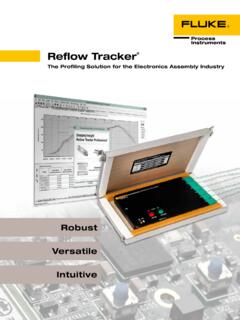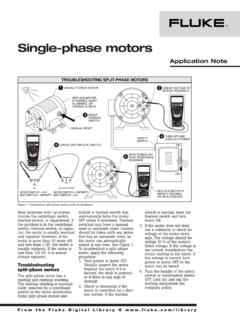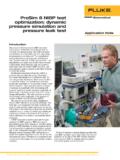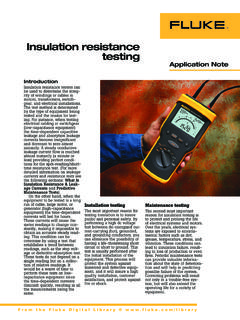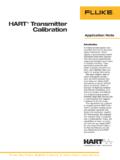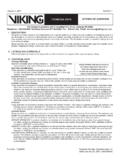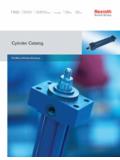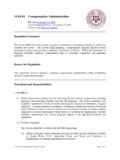Transcription of How to use the new arc-flash PPE tables in the 2018 ...
1 How to use the new arc-flash PPE tables in the 2018 edition of nfpa 70 Eby Jim White, Shermco IndustriesAPPLICATION NOTEOnce again the nfpa 70E Committee has made significant revisions to the table method in the 2018 edition of nfpa 70E Standard for Electrical Safety in the Workplace. Since the 2000 edition of nfpa 70E the task tables have been both a boon and a bane. They were a boon, because in the absence of an incident energy analysis, the tables were often the only method available to choose arc-rated clothing and PPE. They were a bane, because they were difficult to use in the field and reduced the Hazard/Risk Category (HRC) number by 1, 2 or 3 numbers based on perceived risk. Important note on arc-flash labelsIt needs to be stated clearly that the table method is used only if an incident energy analysis has not been conducted.
2 If an incident energy analy-sis has been performed the estimated incident energy exposure to the worker is calculated and an arc flash hazard warning label is applied to the equipment. table (G) has been modified from the existing table (b) in Annex H and is intended to be used when an incident energy analysis has been performed and the equipment labeled. Since table (G) is in the main stan-dard text, it is now part of the standard, instead of the Annex. It is not a mandatory table , though and the 70E says its use is permitted. Incident energy exposures cal/cm2 and below were removed from the table , as the table only applies to arc-rated clothing, equipment and PPE. Overview of the table MethodThe table method has been reduced to three tables ; table (C)(15)(a), table (C)(15)(b)) and table (C)(15)(c).
3 table (C)(15)(A)(a) was revised and part of it is now table (C). table (C) can be used for both the table method and the incident energy analysis method to assist in determining the likelihood of the occurrence of an arc flash . This is an extension of the changes made in the 2015 edition of nfpa 70E that looked to OSHA s Annex E table 1 and eliminates many of the shortcom-ings of the old table method, while also providing better safety for those using level summary of the guidelines:1. It is permitted to use table (C) to deter-mine the likelihood of the occurrence of an arc flash . This table may not be suitable for all work conditions and circumstances and must be used with caution.
4 Best safe work practices would require a complete risk assessment, while using table (C) to verify or supple-ment the results of the risk Refer to the limits included in tables (C)(15)(a) for ac electrical systems or (C)(15)(b) for dc electrical systems. The limits in these table set the maximum available fault current and the maximum operating time of the overcurrent protective device. The mini-mum working distance is also given. If any of these conditions are not within the limits of the tables , the table method cannot be used to select arc-rated clothing and PPE. If the limits are within the table requirements, proceed to table (C)(15)(c). Note that these values are being estimated and no arc flash warning labels will be present.
5 A. A new Informational Note attached to table (C)(15)(a) provides some estimated maxi-mum operating times of common overcurrent protective devices. As with all information such as this, those estimates may or may not be appropriate for the conditions of the task being performed. The equipment must meet all the requirements of (A)(4), Normal Operating Conditions. Some information, such Editor s note: We recommend obtaining the full nfpa 70E standard as a reference. It can be found at Fluke Corporation How to use the new arc-flash PPE tables in the 2018 Edition of nfpa 70 Eas the condition of maintenance, may not be known to the technician performing the task. If any of the conditions cannot be met fully, arc-rated clothing and PPE is always going to be As a matter of safety, it is best to calculate the maximum available short-circuit current available at the secondary of the trans-former s terminal(s) feeding the circuit when using the table method.
6 The 2018 edition of nfpa 70E switched to the phrase available fault current , meaning the current seen at the point of fault. Available short-circuit cur-rent refers to the current that would appear on the transformer s secondary terminal with no impedance. Since an incident energy analysis has not been done, the fault current cannot be estimated, but the short-circuit current The available fault current will almost always be lower than the current calculated at the transformer s secondary terminals, due to circuit impedance. Using short-circuit current will provide a conservative selection of arc-rated clothing and PPE. If the short-circuit current provides an arc flash PPE category that is higher than expected, the available fault current must be calculated and appro-priate PPE selected from that Use table (C)(15)(c) to select the appropri-ate arc-rated clothing, PPE and non-arc-rated PPE for the task and circuit conditions.
7 A. Even though there is no longer an arc flash PPE category 0 in the table method, its use is still mandated by (C)(12), Clothing and Other Apparel Not Permitted . Getting into the details when applying the 2018 tablesWith any given task, a full risk assessment must be performed and documented. table (C) can be part of that risk assessment, but cannot be used as a full arc flash risk assessment. There are some tasks that always present a high risk of injury and these are noted in table (C)such as inserting or removing (racking) a circuit breaker or for the task of voltage testing. Wher-ever the table states the likelihood of occurrence is Yes , arc-rated clothing and PPE are always required for these tasks.
8 For many of the other tasks though, the table will state No . Some-times, Yes is not always yes and No is not always no. The committee added Note * to table (C), which states, *As defined in this standard, the two components of risk are the likelihood of occurrence of injury or damage to health and the severity of injury or damage to health that results from a hazard. Risk assessment is an overall process that involves estimating both the likeli-hood of occurrence and severity to determine if additional protective measures are required. The estimate of the likelihood of occurrence con-tained in this table does not cover every possible condition or situation, nor does it address severity of injury or damage to health.
9 Where this table identifies No as an estimate of likelihood of occurrence, it means that an arc flash incident is not likely to occur. Where this table identifies Yes as an estimate of likelihood of occurrence, it means that additional protective measures are required to be selected and implemented accord-ing to the hierarchy of risk control identified in (H). Note * contains very important information. By stating that the table s assessment of the likeli-hood of occurrence cannot cover every possible condition or situation should make everyone s ears perk up. When the table provides a No it could mean that further assessment is really required, as the committee cannot foresee every possibility.
10 A yes answer indicates the user of the table should apply the hierarchy of risk control methods. PPE is the very last risk control method. (H) also states that PPE is one of the least reliable methods of controlling risk. All of this needs to be included as part of the risk assessment condition of maintenance of the equipment is a common reason for PPE and arc-rated cloth-ing to be required for a job. In large industrial facilities where there are electrical engineers and maintenance workers, condition of maintenance may not be an issue, but for smaller industrial facilities and for many commercial sites it can be. If there is any question about the condi-tion of maintenance, the worker is automatically required to wear the PPE else to take note of is that the tasks in table (C) are much less specific than in the old table (C)(15)(A)(a).




